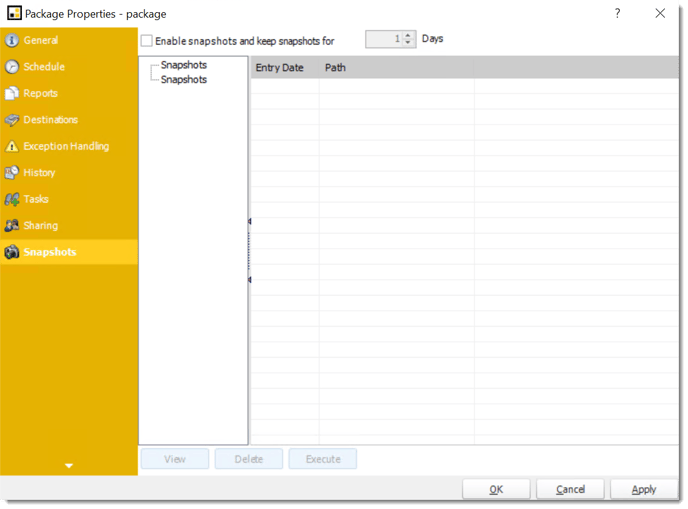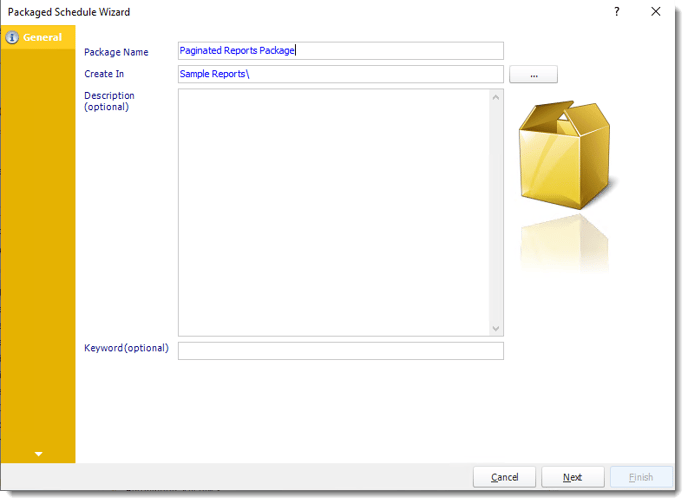How do I setup a Package Reports Schedule for Power BI Service Paginated Reports in PBRS?
The purpose of the wizard will be to guide you through the process of setting up a number of reports to be generated at defined intervals and delivered to one or more defined destinations - together.
This article applies to:
- Power BI Service Paginated Reports (Cloud - Power BI Report Server)
Package Report Schedule for Power BI Service Paginated Reports.
The purpose of the wizard will be to guide you through the process of setting up a number of reports to be generated at defined intervals and delivered to one or more defined destinations - together.
Example: Your entire monthly report pack (consisting of a number of reports) can be sent to a recipient with all reports attached to the single email. You can also zip up the reports into a single zip file, or export them out to a single Excel workbook, or export them in a single PDF file.
How to Create a Package Schedule Report for Power BI Service Reports & Dashboards?
Step 1 - Navigate to Package.

Step 2 - Complete the General Tab of the wizard.
General Wizard
- Package Name: The name of the package.
- Create In: The PBRS folder where the package is stored.
- Description: A short description to help other users identify exactly what this schedule is and what it is expected to do.
- Keyword: Enter some keywords which can be used later by Smart Folders to identify this schedule.
Step 3 - Click Next to continue to the next wizard section.
Schedule Wizard
Step 4 - In this section, you will decide when the report will execute. There are a variety of options.
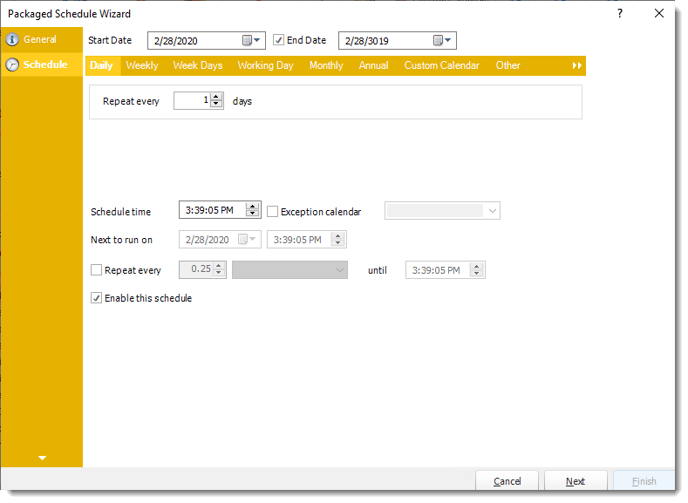
- Daily: Run a report every day or at a frequency of days.
- Sub options: Repeat every X Days.
Example: Run the schedule every 3 days.

- Weekly: Run a report on a weekly time frame.
- Sub options: Repeat every X weeks.
Example: Run the schedule every 2 Weeks.
- On: Select the specific days of the week the schedule will run. If only once a week, select only the day of the week it will run.
Example: Run every Monday, Wednesday, and Friday.

- Week Days: Run the schedule Monday through Friday.

- Working Day: Run the schedule starting on a specific day of the month. Indicate which day of the month the schedule will run. E.G. run the schedule on the 4th working day of the month.

- Monthly: Run the schedule on a monthly time frame.
- Use the following options: Checking this box will enable you to select frequency options such as the “last Thursday of the month.” Also you can include or exclude specific months from the schedule.

- Annual: Run the schedule every year at a specified time.

- Custom Calendar: Select the custom Calendar you wish to use. You can create a new custom calendar from the menu as well. Please see Custom Calendars for more information.

- Other: Other scheduling options.
- Run Schedule every X Minutes, hours, days, weeks, months, years.

- None: No scheduling is required for this item.

- Start Date: Enter the desired starting date for the schedule. This section can be the current date (providing schedule time has not already passed) or a date in the future.
- End Date: If the schedule is due to end after a certain date enter that here. If the schedule is to run indefinitely, then leave it blank.
- Schedule time: On the Next Run date, the package will run at this time.
- Exception Calendar: Choose a calendar that will instruct the schedule to NOT run on those specified days. Please see Custom Calendars for more information.
- Next to run on: The package will next run on this date.
- Repeat Every: Rerun the package every x minutes from the scheduled time until your specified time.
For example, you can set up a daily package to run every day at 8 am and to run every hour until 5 pm.
- Until: After this date, there will be no automated scheduling of this package.
- Enable this Schedule: Uncheck this option to Disable the package. Disabled packages are not deleted, but they do not execute automatically. You can re-start the automatic scheduling at a later date by checking this option again. Or right-clicking this schedule from the main screen and selecting Enable.
Step 5 - Click Next to continue to the next wizard section.
Destinations Wizard
Step 6 - In this section, you will decide where your schedule will be delivered. The list in the center will display the list of destinations you have added to the schedule. You can organize the various destinations’ order by clicking on the green up and down arrows.
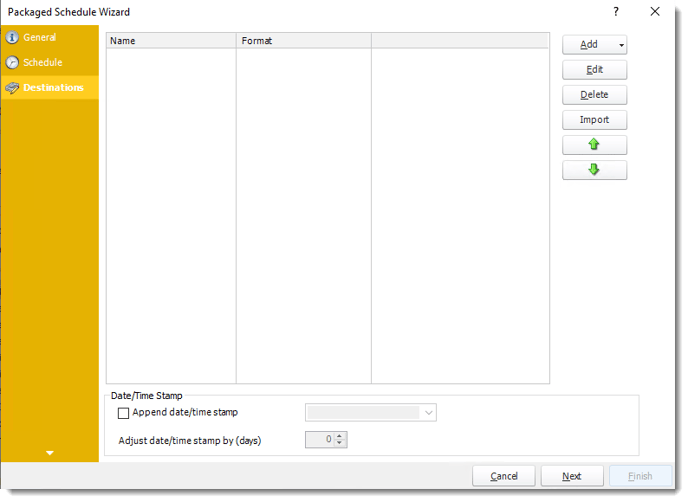
-
- For more information of adding destinations, click here.
- For more information about Output Formats, click here.
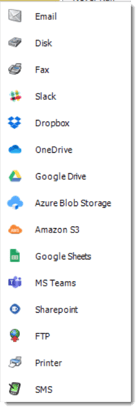
- Edit: Select a destination and click to edit it's properties. Or simply double-click on the destination.
- Delete: Select a destination and click this button to delete it.
- Import: Click here to import from the list of default destinations.
Step 8 - Click Next to continue to the next wizard section.
Reports Wizard
Step 9 - A package may be created with no constituent reports and then the reports can be added later.
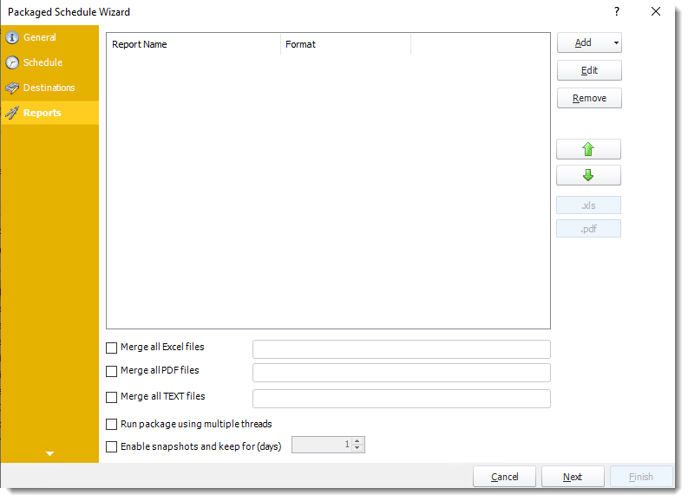
However, you may also add reports at this stage in the wizard - and amend, delete or add some more later.
- Merge all Excel Files: PBRS will then merge all excel outputs in the package into a single excel file.
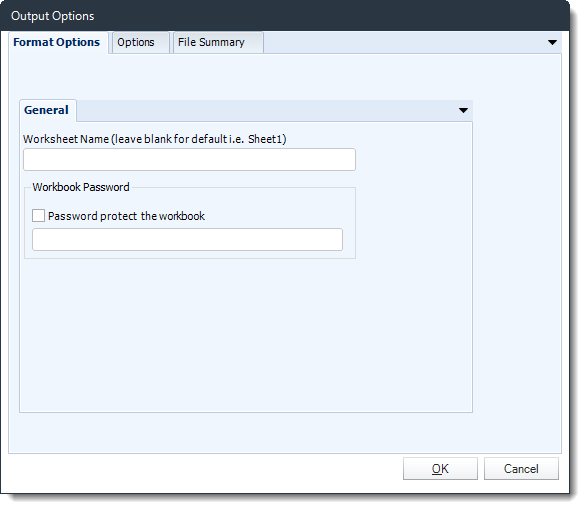
HINT: Add Password Protection to this section in this option window rather than the individual report in the package. This will password protect the entire merged workbook.
- Merge all PDF Files: Merge PDF outputs into a single PDF file. The reports will appear in the merged PDF in the order they are displayed in the package schedule. Checking this box will bring up additional PDF Options.
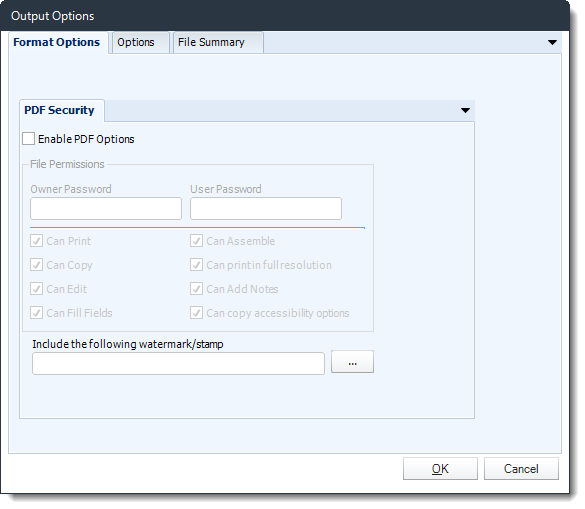

- Package Report Properties will appear on.
Adding a Report to the Package
Report Wizard
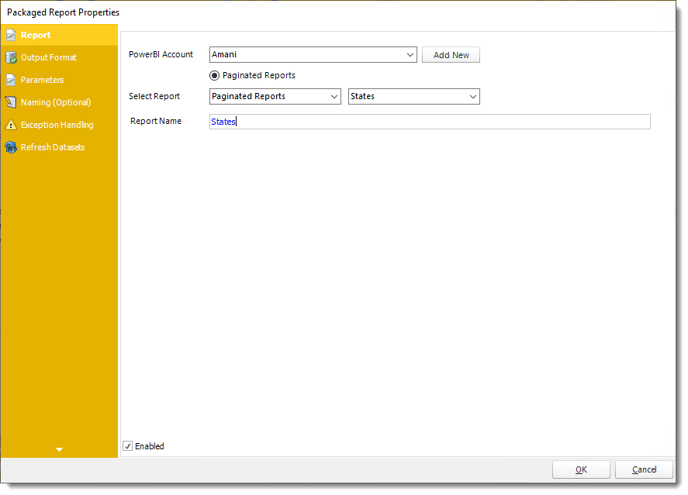
Step 2 - In the Select Report field use the dropdown lists to select the required reports.
Step 3 - Enter a name for the report.
Step 4 - Check the option to Enable this report within the package. If this option is unchecked the report will be added to the package but it will not be executed.
Output Format
Step 5 - In this section, you will select the output format of the report.
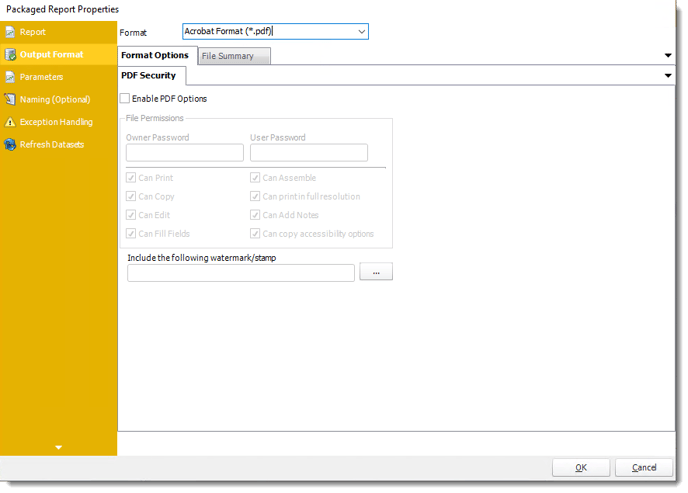
- For more information on Output Format, click here.
Parameters
Step 6 - In this section, you will determine the parameters for your report (if any). If your report has no parameters, you may skip this section by clicking next.
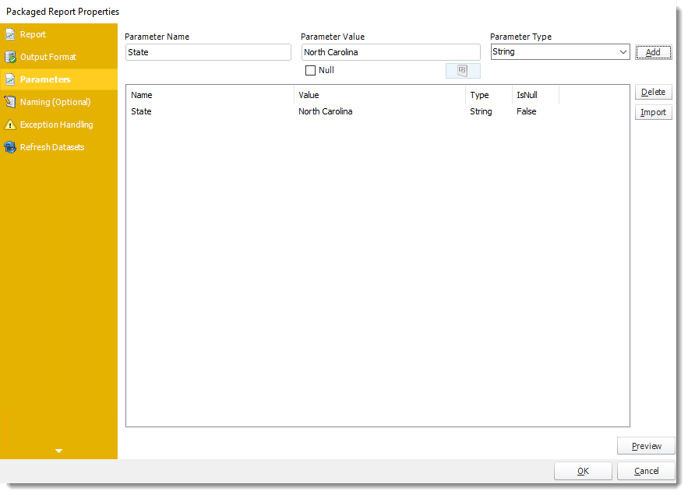
- Parameter Name: Enter the parameter name of your report.
- Parameter Value: Enter the parameter value of your report.
- Parameter Type: Use the drop-down menu to select the parameter.
- Click Add to add the parameter value.
- Import: Use this option to add parameter values using a URL from Power BI Service to import a parameter to this report.
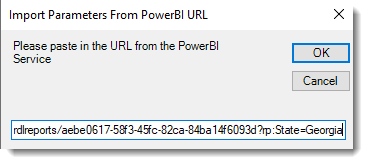
- Click OK.

- Preview: View the report output given the selected parameters.
Naming (Optional)
Step 7 - Here you may customize the output file name, output extension, and append Date / Time to the exported report.
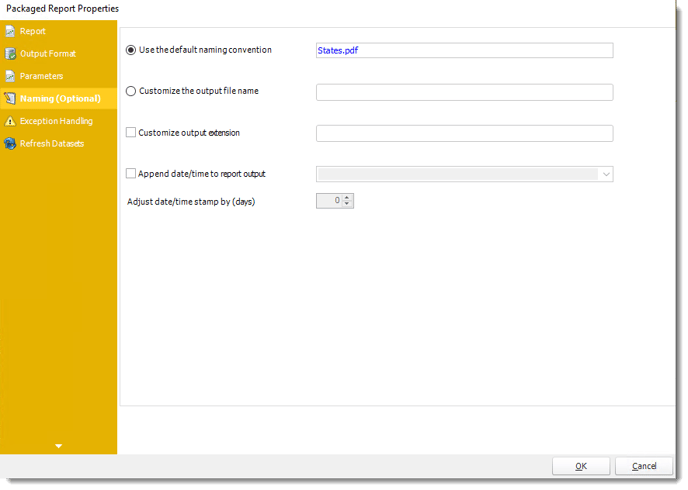
- Default Naming Convention: PBRS will name the output file in the following format: reportname.format extension, e.g. Catalog Report.pdf.
- Customize the output file name: Choose your own filename or right-click and use the Insert Function to insert a value.
- Customize output extension: Choose your own extension. This is useful for system integration. For example, the default extension for a character separated file is "CSV," but you can give your export an extension of "txt" so that the file can be read by another already existing system you may have. You may also right-click and use the Insert Function to insert a value.
- Append date/time: This is useful for the following reasons:
- If the filename is the same each time, and it is being exported to the same folder each time, then it will be overwritten by the latest one each time. By appending date and time to the filename, each file remains unique, and no files are overwritten.
- You can track which reports ran and when they ran by looking at what the report is named.
Exception Handling
Step 8 - In this section you will determine what action should be taken if a Report Export is Blank or if the Report Export Fails.

- Run custom tasks when the following exception occurs: Check this is option to enable the following options.
- Report is Blank: If a report is blank because it genuinely returned no data, recipients can misconstrue this as an error with the scheduler. This option allows you to identify genuine empty reports and instruct PBRS on what to do with them.
- Report exports fail: If a report export fails, you can receive a notification or run a tasks that the report failed to execute.
Actions
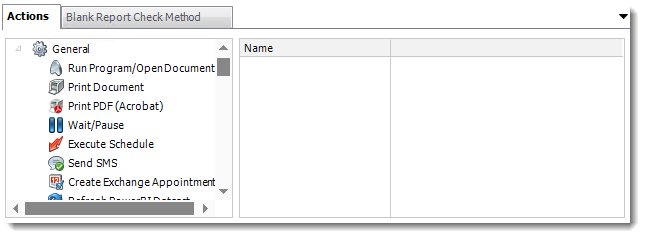
- Select an action from the task list. This task will be executed in the event that a schedule is blank.
- For more information about tasks, click here.
You can send a notification if a report is considered blank instead of sending the report. Simply select “check if a report is blank” then select “Ignore the report.” In the actions tab, select “Send Email” from the list. Compose your email and save.
Blank Report Check Method
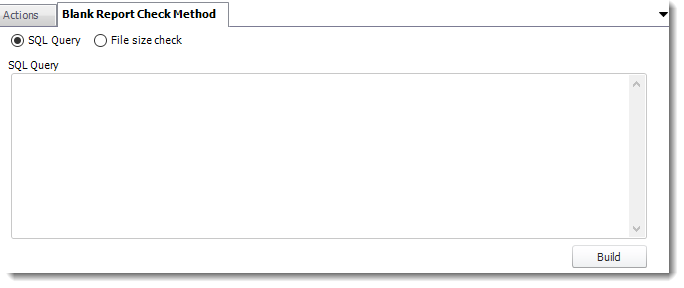
- Select the Method that will determine whether a report is blank.
- SQL Query: Select this option to use a user made query that will determine if the report is blank. If the query returns no results, the report is blank.
- Click Build.
- Get values from a database window will appear. For more information about Get values from database, click here.

- File size check: Assume reports is blank if size is under "X" bytes.
- Click OK.
Refresh Datasets
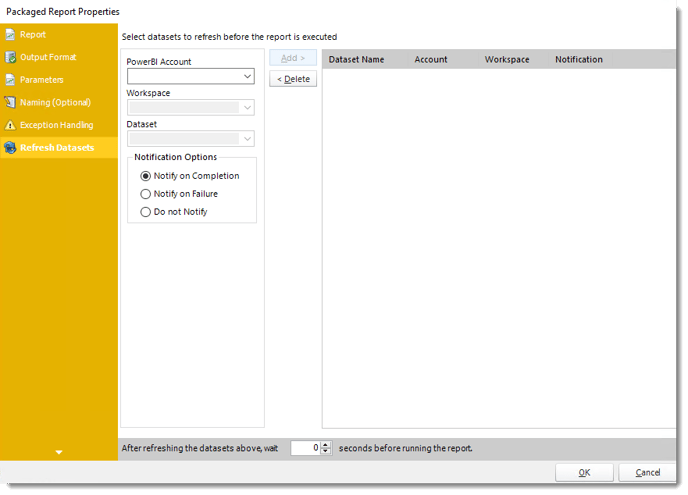 In this section select the datasets to refresh before the report is executed.
In this section select the datasets to refresh before the report is executed.
- Power BI Account: Select the account to refresh datasets.
- Workspace: The path to the required report.
- Dataset: Select the dataset.
- Notification Options: Receive a notification after the report is executed, the report failed to execute, or do not receive a notification.
- After refreshing the datasets above, wait 'X' seconds before running the report.
Exception Handling
Step 11 - In this section you will determine Schedule Retries should an error occur and set up what action should be taken if a Report Export is Blank or if the Report Export Fails.

- Treat as “error” if not completed in X minutes: If a report takes longer than the specified amount of time to run, this option will treat the schedule as an error and follow the appropriate action. The “Auto-calculate” option instructs PBRS to automatically determine how long a schedule should take to run the report. If it takes longer than the calculated amount of time, then it is an error.
If manually determining the error timing, please double-check the run time of the report in order to get the correct time estimate.
- On error, retry executing schedule every: If set to 0, PBRS will deem the schedule as "Failed" the first time it encounters an error. The schedule will not run again until its next scheduled time. Change the value to tell PBRS how many times you want it to retry running the report before declaring it as "Failed."
- Run custom tasks when the following exception occurs: Check this is option to enable the following options.
- Report is Blank: If a report is blank because it genuinely returned no data, recipients can misconstrue this as an error with the scheduler. This option allows you to identify genuine empty reports and instruct PBRS on what to do with them.
Actions

- Select an action from the task list. This task will be executed in the event that a schedule is blank.
- For more information about tasks, click here.
You can send a notification if a report is considered blank instead of sending the report. Simply select “check if a report is blank” then select “Ignore the report.” In the actions tab, select “Send Email” from the list. Compose your email and save.
Blank Report Check Method

- Select the Method that will determine whether a report is blank.
- SQL Query: Select this option to use a user made query that will determine if the report is blank. If the query returns no results, the report is blank.
- Click Build.
- Get values from a database window will appear. For more information about Get values from database, click here.

- File size check: Assume reports is blank if size is under "X" bytes.
Step 12 - Click Next to continue to the next wizard section.
Custom Tasks
Step 13 - In the section you have the option of setting up Custom Tasks. Custom tasks are business process automation tools that can be auto triggered before or after a report runs. Simply navigate to the task you would like to set up and drag & drop to the right hand side of the screen. This will automatically open the Configuration screen for the selected task.
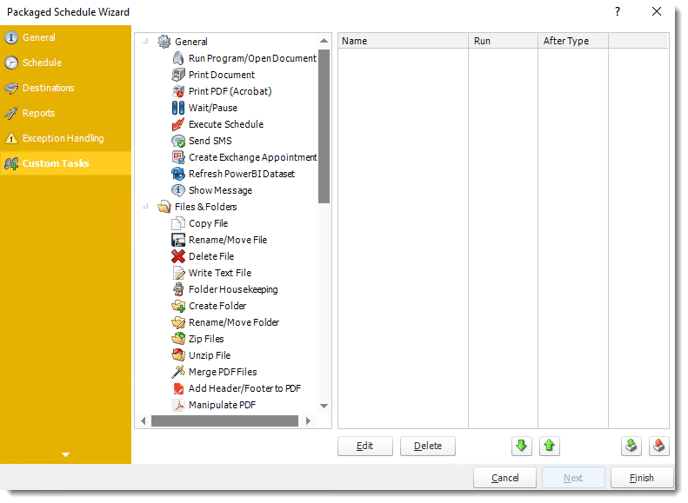
- For more information on Custom Tasks, click here.
Step 14 - If you have no desire to add a Custom Task, you can click finish to complete the schedule.
Package Report Schedule Context Menu
Right-Click on a schedule to see the following actions.
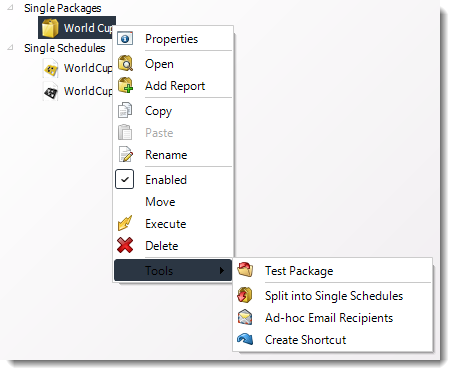
- Properties: Edit the schedule from here. Or you can just double click on the schedule.
- Open: This will open the package and show its constituent reports.
- Add Report: Use this to add one or more reports to an existing package.
- Copy: Use this to copy the schedule. Right-click in the "white space" of the folder you wish to copy it to and select the Paste button.
- Rename: Rename the package.
- Enabled: Schedules are enabled when there is a check icon beside this option. To stop a schedule from running, or to "pause" it for a while, select this option to remove the check icon. Disabled schedules will not run until they are enabled again.
- Move: Use this option to move the report into an existing package.
- Execute: This button will execute the schedule immediately. Note that the next run date and time is not moved on as a result of a manual execution. They only move on if the schedule is run automatically by one of the schedulers .
- Delete: Selecting this option will delete the schedule.
- Test Package: Use this option to test the schedule and export it to selected "test" destinations.
- Split into Single Schedules: This will split all the constituent reports in the package into Single Report Schedules.
This process will automatically delete the package once the splitting process is completed.
- Ad-Hoc Email to Recipients: Select this option to send an ad-hoc email to all recipients of this package. You can use this to alert recipients to a planned system outage, or any other useful information.
- Create Shortcut: Use this option to create a shortcut you can save in any location on your PC. Execute the shortcut to execute the schedule in PBRS.
Package Report Schedule Properties
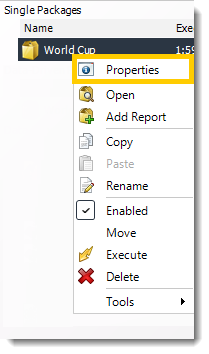
- To access your schedule properties, right-click on a schedule and select properties.
- Similar to the schedule wizard, you adjust settings to your schedule such as timing, error handling, or custom tasks.
- General
You can view the Schedule Unique ID in the General Wizard.
- Schedule

- Reports

- Destinations

- Exception Handling

- History: Review the schedule's history. Successes, failures, and other data is located here.
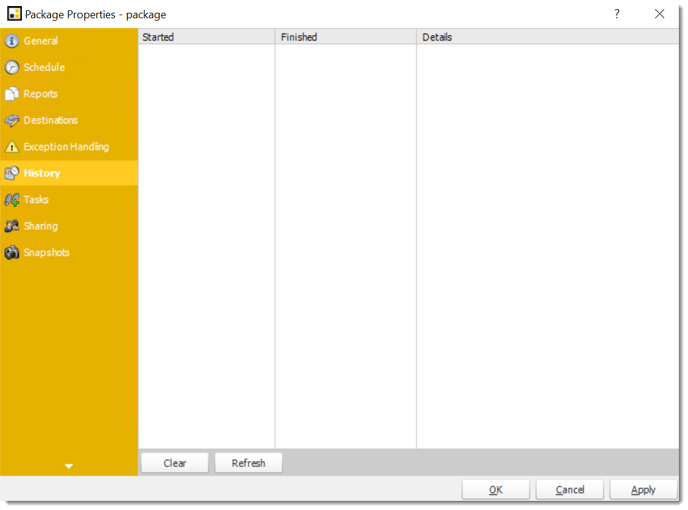
- Tasks

- Sharing: Here you can share this schedule with multiple users.
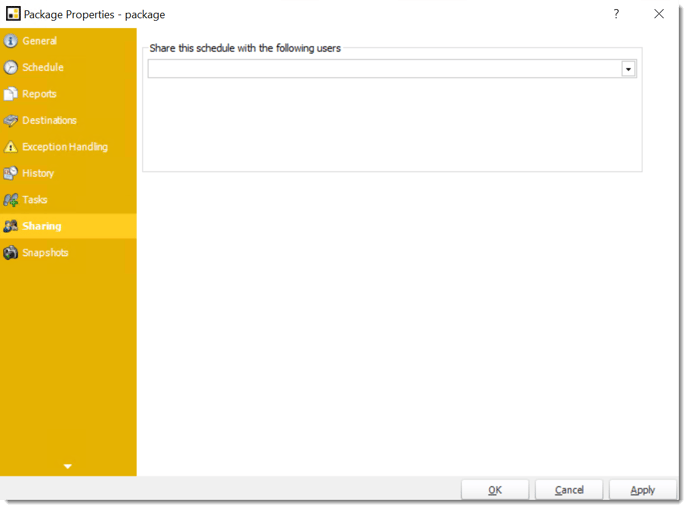
- Snapshots: A snapshot is a copy of each report a schedule or a package generates. Keeping snapshots enables you to resend past reports without generating them afresh - especially if the data has changed in the meantime.
- Simply select the number of days to keep the snapshots.
